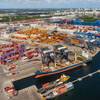Great Lakes Iron Ore Trade Off 3.6 Percent
Iron ore shipments on the Great Lakes totaled 5.5 million tons in October, a decrease of 6 percent compared to September, and 3.6 percent below the level of a year ago. Shipments were, however, marginally ahead of October’s 5-year average.
Shipments from U.S. ports totaled 4.5 million tons, a decrease of 11.1 percent compared to a year ago. Included in that total were 81,000 tons shipped to Québec City for final delivery overseas.
Loadings at Canadian ports jumped more than 60 percent to 950,000 tons.
Through October the iron ore trade stands at 50 million tons, an increase of 2.5 percent compared to a year ago, and 14.6 percent better than the 5-year average for the January-October timeframe.
Shipments from U.S. ports are virtually tied with a year ago, and 14.6 percent ahead of their 5-year average. Cargos destined for Quebec City for transshipment overseas total 3.5 million tons through October.
Loadings at Canadian ports are up 23.3 percent compared to a year ago, and 14.3 percent ahead of their 5-year average.
Lake Carriers’ Association represents 17 American companies that operate 57 U.S.-flag vessels on the Great Lakes and carry the raw materials that drive the nation’s economy: iron ore and fluxstone for the steel industry, aggregate and cement for the construction industry, coal for power generation, as well as salt, sand and grain. Collectively, these vessels can transport more than 115 million tons of cargo per year.













